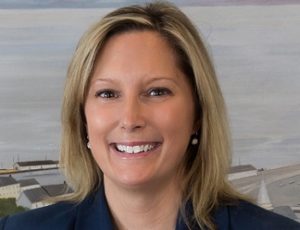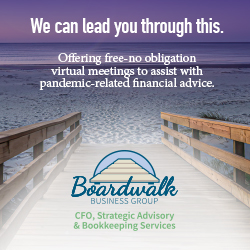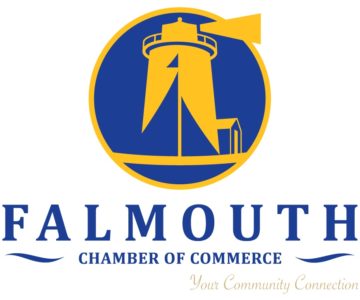Truro native Lori Meads has deep roots in the community where she lives, and where she works. That connection to community is invaluable in her role as president and CEO of Cape Cod’s oldest community bank.
Meads grew up in Truro and still lives there with her husband, daughter and two dogs. She attended Provincetown High School and Bryant University in Rhode Island, and in 2017 she earned an MBA from the New England College of Business and Finance.
“When I got out of college the job market was not very fruitful,” recalls Meads. So, she found her first job as manager of the Gap store in the Cape Cod Mall, where she stayed for a year and a half. “I realized retail was not my thing,” recalls Meads.
As luck would have it, she saw a job listing for Seamen’s Bank and the rest is history. Meads started as a teller in 1992, advanced into customer service, and then became administrative assistant to the president, John Roderick.
“He mentored me,” says Meads of Roderick. That led to a series of vice president jobs, and in 2017 Meads was named CEO. A year later she became both president and CEO.

The smallest of the Cape’s three community banks (the others are the Cooperative Bank of Cape Cod, better known as the “Coop,” and Cape Cod Five), Seamen’s Bank has five branches and a loan center, located in Provincetown, Truro, Wellfleet and Eastham. The bank employs about 70 people. While its physical footprint is limited to the Outer Cape, the bank does business as far as Harwich and Brewster.
An Outer Cape Fixture
Seamen’s has been a fixture on the Outer Cape since its founding in 1851, and is the Cape’s oldest bank. It’s that connection to the Outer Cape community that is the bank’s greatest asset, says Meads.
“I think the culture’s a little different on the Outer Cape. Understanding that is one of the bank’s strengths,” explains Meads.
For commercial customers that means the bank anticipates the seasonal cycle and structures loans appropriately.
Just as Outer Cape businesses are highly seasonal, their employees are too. “It’s kind of a domino effect,” explains Meads.
Rather than sell mortgages to a third party, as many banks do, Seamen’s Bank keeps many of their mortgages in-house. Doing so gives them more flexibility in their mortgage lending, Meads explains.
“If we have someone who can’t check all the boxes, we can help them,” says Meads.
The bank’s board of investment meets weekly, so it can respond quickly with lending decisions. “We can respond a lot quicker,” says Meads, who adds that the members of the board of investment are members of the community and know the community well.
The Role of Women in Banking
With Meads’ promotion to CEO in 2017, now all three community banks on the Cape are led by woman. Meads isn’t surprised by that, noting that 70 percent of the staff at Seamen’s are women.
She thinks that speaks to a trend of women in banking and finance. “It’s a sign of the times. Fifty years ago, banking was male dominated, not anymore.”
The high percentage of female employees may be partly due to the bank’s commitment to daycare. The roots of that commitment date back 21 years, when Meads was expecting the birth of her daughter. She was asked by the Cape Cod Children’s Place, of Eastham, to participate in a focus group to better understand the needs of new parents and examine if businesses were losing employees due to lack of daycare options. The Cape Cod Children’s Place is a nonprofit organization that provides care, support, and advocacy for families with young children.
Sea Babies
Meads stayed involved with the Children’s Place, which eventually established a daycare center called Sea Babies at the Wellfleet Council on Aging, which was then being constructed. The bank agreed to help subsidize the operation if it wasn’t fully enrolled. The Bank now pays 65% of the cost of day care for bank employees who use the center. Sea Babies has proved very successful and there’s been a waiting list every year. The number of bank employees who use the benefit varies – at times it’s been as many as six employees.
The bank advertises the benefit in its job listings, and according to Meads, “It’s been a huge draw. People are shocked we offer this as a benefit.”
She says it makes good business sense because it helps retain valuable employees, noting that the model is being promoted elsewhere.
“It’s now a necessity, especially here. Families need two incomes, which is a challenge without affordable daycare,’ explains Meads.
Employees are thus able to be part of a two-income family and have the peace of mind knowing their children are well cared for. “We’ve been able to keep so many employees,” she says.
For the future, Meads says the bank will continue doing what it’s been doing for 169 years: focusing on its community, understanding its needs, and being flexible. She stresses the bank’s focus on service, and not trying to sell financial products and services that customers aren’t interested in.
With the advent of online banking and virtual competition, she says, “We just have to be that much more on our game.”
But she insists there will always be brick and mortar branches. “There will always be a time when you need to sit down with a human being. Most people love banking online, but when something goes wrong they’re going to want to talk to someone who can help.”






















